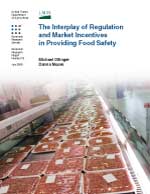Economic Research Report No. (ERR-75) 52 pp
The Interplay of Regulation and Marketing Incentives in Providing Food Safety
This report examines the impact of process regulations mandated under the Pathogen Reduction/Hazard Analysis and Critical Control Point (PR/HACCP) rule by the Food Safety and Inspection Service of USDA on food safety process control. The current level of food safety found in U.S. meat and poultry food products is a result of process and performance regulations and management-determined actions brought about by market incentives. Processing regulations include sanitation and other tasks related to food safety; management-determined actions include capital investment and other actions independent of process regulations, but possibly driven by performance standards. Performance standards-regulations that allow manufacturers to reach an acceptable level of food safety in any manner they see fit-are not a subject of this report. This study used the share of samples testing positive for Salmonella spp. as a measure of food safety process control in meat and poultry processing plants and found empirically that management-determined actions account for about two-thirds of the reduction in samples testing positive for Salmonella spp., while process regulations account for about a third of the reduction. The importance of process regulation varies, but accounts for 50 percent or more of process control in about a quarter of plants, and in some plants accounts for the entire process control system.
Keywords: Food safety, process regulations, Hazard Analysis and Critical Control Point (HACCP) rule, food safety regulations
In this publication...


